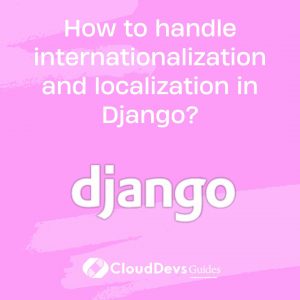Django Q & A
How to handle internationalization and localization in Django?
Handling internationalization (i18n) and localization (l10n) in Django is essential for making your web application accessible and usable by users from different regions and language backgrounds. Django provides robust support for i18n and l10n through a set of features and tools:
- Enable i18n in Settings: To enable internationalization in your Django project, you need to set the `USE_I18N` setting to `True` in your project’s settings file. This tells Django to use translation features.
- Mark Strings for Translation: In your Python code, wrap all user-facing strings that need translation with the `gettext` function, often aliased as `_()`. For example:
```python
from django.utils.translation import gettext as _
message = _("Welcome to our website!")
```
- Create Translation Files: Run the `makemessages` management command to extract marked strings and create translation files for different languages. You can then translate these strings in the generated `.po` files.
- Compile Translations: After translations are completed, compile them into binary `.mo` files using the `compilemessages` management command.
- Configure Locale: Set the `LANGUAGE_CODE` and `TIME_ZONE` settings in your project’s settings file to reflect the desired default language and time zone. Users can change these settings on your website.
- Use Translated Templates: In your templates, use the `{% trans %}` template tag to translate text. For example:
```html
<h1>{% trans "Welcome to our website!" %}</h1>
```
- Set Language Preference: You can allow users to choose their preferred language by implementing language selection mechanisms in your views or templates. Django provides a `set_language` view that handles language switching.
- Date and Number Formatting: Django’s template filters and settings like `DATE_FORMAT` and `NUMBER_GROUPING` help with localizing date, time, and number formats based on the user’s locale.
By following these steps, you can make your Django application multilingual and culturally aware, providing a more inclusive and user-friendly experience for a global audience. Django’s i18n and l10n features streamline the process, making it easier to manage translations and adapt your application to different languages and regions.

Previously at


Argentina

GMT+2
Experienced Full-stack Developer with a focus on Django, having 7 years of expertise. Worked on diverse projects, utilizing React, Python, Django, and more.


